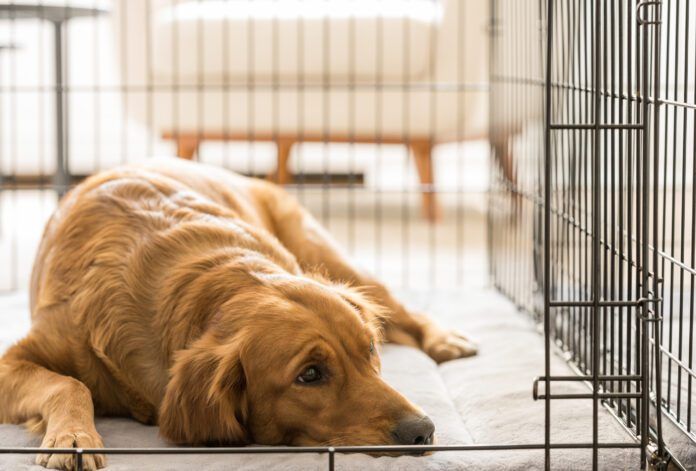Perhaps you adopted an older dog. Congratulations and thank you! Or you never crate-trained the dog you got as a puppy, and now he’s 4 or 5 years old and household requirements changed, causing him to sometimes be crated. Or maybe you adopted a second dog or puppy, and the senior dog needs to be crated when you feed the youngster.
These are a few of many reasons why you might need to teach your older dog to eat or sleep—or just stay—in a crate. It’s not hard, but it may require patience from you.
Basically, you must assure your dog that the crate is a safe, protected place to go. It’s a place where he can relax. It’s his place. Never crate him in anger; if you are upset about something he did, just use your “Go crate” cue and treat him for going into the crate. He will not associate the treat with what he did that you didn’t like; it’s for going in the crate on cue.
You need a crate that’s big enough for him to stand, lie down, and to move around. Large dogs need big crates, so be sure there’s room for that in your home. And the crate needs a soft, comfortable bed, not a towel tossed in for good measure.
It’s simple to use food or treats to teach him to go into his crate. Feed him his meals in the crate, with the door open so he can come and go as he chooses (it’s a good idea to bungee or tie the crate door so it doesn’t move around—and we’re not going to close it during initial training). We’re setting the crate up to be “his” place, one where he gets food, relax on a soft bed, and knows he can leave.
Use treats, and give him a cue like, “Go crate,” and place a treat just inside the door of the crate. You will increasingly toss the treat farther back in the crate. Let him go in, get the treat, and leave. Repeat this frequently. Note: It’s extremely important that you continue to reward him for going in the crate. Always and forever—even after he’s trained.
Once your dog is staying in the crate for a little bit (like 15 seconds) on his own, you can toss in a treat, let him go in, and shut the crate door. Take a step back, say “Good boy!” and open the door and give him a treat. Repeat this with gradually longer amounts of time and with you a little farther away from the door each time. Intersperse longer with shorter periods with the door shut.
Eventually, as you slowly build up the time he’s in the crate, you’ll see that he starts to relax, just waiting for his reward for being a good boy and quietly relaxing in his crate.
Dogs with separation anxiety are more difficult to teach to crate, and some of these dogs have injured themselves if they have an anxiety attack while crated. Get help from a professional fear-free or force-free trainer and discuss separation anxiety with your veterinarian or a veterinary behaviorist. Some medications can help.
Note: There are crate alternatives for confining your dog, such as exercise pens (ex-pens), tethers, and so on. See “Creative Confinement: Dog Crate Alternatives.”







I will never understand why anyone would get a dog, then keep him locked in a cage. Stop calling it a crate. It’s a cage from which the dog cannot escape. Dogs locked in cages like this are found after house fires. They never even had a chance and died horribly. There is nothing natural about caging an animal. For all the good dog care advice that Whole Dog Journal provides, I wish you would stop encouraging people to get dogs for which they are unable or unwilling to care for, then lock them in cages for 8+ hours a day, to try to “hold it,” or sit in their own urine and excrement. It’s absolutely appalling. Don’t get a dog if all you want to do is sadistically torment an animal.
Hi Bobbie, I am sad that you feel that way about crating and no doubt there ARE folks who crate their dogs way too much! But the crate is such a great way to keep your dog (and visitors!) safe. Our personal dogs are loose much of the day but eat in their crates (which keeps them from eating too fast and stealing each other’s food) and retire to their crates when one of the other dogs is being overly enthusiastic. And I cannot say enough about helping new dogs in the house learn not to potty inside. If the folks who surrendered their dogs to our local shelter (where I walk dogs) had crate trained their dogs then I will be a lot of them would not be at the shelter. Let’s be kind to each other and let there be space for caring for and loving our best dogs in lots of different ways.
Bobbie, I understand your point of view and concerns, and do agree with you, but crate-training also does have its place, such as what is outlined in this article. It can also be critical in the case of a natural disaster emergency or the like, when you are forced to go to a shelter. Many shelters will only accept your dog with you if they are crated. I’d rather have my dog not stressed further (in an already stressful circumstance) by having him/her familiar with the crate, and with me/the family, than otherwise separated because it was not crate trained.